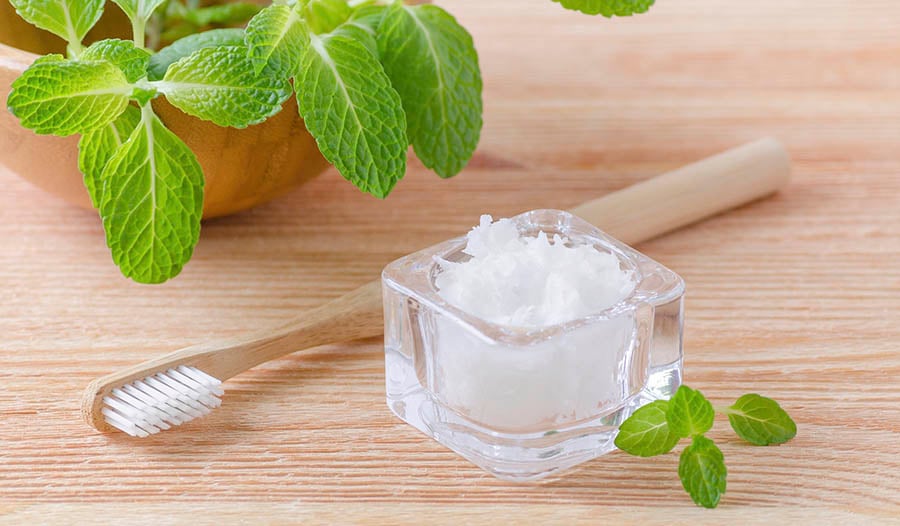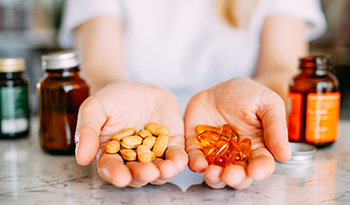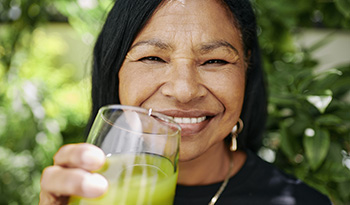Che cos'è l'oil pulling e quali sono i benefici per la salute?

Pubblicato originariamente a settembre 2018 / Aggiornato a luglio 2023
Che cos'è l'oil pulling?
L'oil pulling è una pratica antichissima della medicina ayurvedica per promuovere la salute orale e sistemica, che sta guadagnando popolarità e validazione scientifica.
L'olio viene estratto e spinto tra tutti i denti durante il processo di sgrassatura per rimuovere placca, batteri e detriti cellulari indesiderati dalla cavità orale e creare un ambiente orale più sano.
L'oil pulling è considerato dalla medicina ayurvedica una pratica sanitaria essenziale. Ha senso perché, per molti aspetti, la bocca rispecchia la salute generale del corpo umano. Se riusciamo a migliorare la salute orale, ne consegue un miglioramento della salute generale.
L'oil pulling può migliorare efficacemente il microbioma orale. La cavità orale ospita miliardi di microrganismi ed è ormai assodato che alcuni di questi microbi possono contribuire allo sviluppo o alla progressione di malattie sistemiche, cardiopatie, disturbi autoimmuni e molto altro.
Il mantenimento della salute orale è fondamentale per il mantenimento della salute generale. L'oil pulling può essere una pratica semplice ed efficace per promuovere una salute orale e generale ottimale.
Come fare l'oil pulling
- Assumere da un cucchiaino a un cucchiaio di olio di cocco o di altro olio alimentare.
- Tenetelo in bocca.
- Passarlo tra i denti per un tempo compreso tra i cinque e i venti minuti al mattino, prima di lavarsi i denti.
- Sputare l'olio, facendo attenzione a non ingerirlo.
- Lavarsi i denti.
Benefici dell'estrazione dell'olio di cocco
L'oil pulling può essere praticato con qualsiasi olio alimentare, ma l'olio di cocco può offrire i benefici più significativi per molte ragioni. Circa il 50% degli acidi grassi presenti nell'olio di cocco è costituito da acido laurico, un grasso saturo a catena media (12 carboni).
L'unica altra fonte abbondante di questo grasso salutare in natura è il latte materno umano. Nella bocca e nel tratto gastrointestinale, l'acido laurico viene convertito in un composto altamente benefico chiamato monolaurina. Un altro grasso presente nell'olio di cocco, l'acido caprico, viene convertito in monocaprina.
Entrambi i composti hanno dimostrato significativi effetti antimicrobici che distruggono vari organismi che causano malattie. Si tratta di un'azione molto benefica all'interno del latte materno, ma può essere utile anche attraverso l'olio di cocco.
Molti virus, batteri e protozoi (parassiti) sono avvolti da una membrana protettiva composta da lipidi (grassi). Le ricerche attuali indicano che la monolaurina e la monocaprina sciolgono i lipidi dell'involucro grasso che circonda questi microbi. Disgregano lo scudo protettivo e sono facilmente distrutti dal sistema immunitario. Tra i batteri inattivati dalla monolaurina ci sono quelli legati alla carie e alle infiammazioni gengivali. Aiuta inoltre a combattere la crescita eccessiva del lievito Candida albicans. In uno studio, i ricercatori hanno scoperto che tutte le Candida erano sensibili al 100% all'olio di cocco.
Uno studio ha anche esaminato l'effetto dell'oil pulling con olio di cocco in uno studio clinico randomizzato e controllato su 60 soggetti. I soggetti sono stati divisi in tre gruppi:
- I soggetti del gruppo A hanno sciacquato la bocca al mattino con 10 ml di olio di cocco per dieci minuti.
- I soggetti del gruppo B hanno sciacquato la bocca al mattino con 5 ml di collutorio alla clorexidina per un minuto.
- I soggetti del gruppo C hanno sciacquato la bocca al mattino con 5 ml di acqua distillata per un minuto.
I ricercatori hanno cercato l'effetto del gruppo cocco rispetto al gruppo clorexidina su Streptococcus mutans, il batterio orale legato alla carie. La clorexidina è un popolare collutorio antimicrobico da prescrizione. In questo studio, l'olio di cocco è risultato uguale alla clorexidina nel ridurre la conta di S. mutans nella saliva.
In un altro studio condotto su 60 adolescenti di età compresa tra i 16 e i 18 anni con gengivite (infiammazione delle gengive) dovuta alla placca dentale, il pulling con olio di cocco ha prodotto benefici significativi. Le misurazioni oggettive della gengivite e della placca sono diminuite del 50% dopo quattro settimane. Questi risultati sono simili a quelli prodotti dalla clorexidina. Gli autori concludono: "L'oil pulling si è dimostrato un metodo efficace per ridurre la formazione della placca e la gengivite indotta dalla placca".
I principali vantaggi dell'uso dell'olio di cocco rispetto alla clorexidina sono che è più sicuro e privo di effetti collaterali. La clorexidina è problematica perché gli effetti collaterali sono comuni e comprendono la colorazione dei denti, la secchezza o l'irritazione della bocca, un sapore insolito o sgradevole in bocca e reazioni allergiche.
Quanto tempo ci vuole per vedere i risultati?
La maggior parte delle persone percepisce la differenza nella sensazione di morbidezza e pulizia dei denti la prima volta che esegue l'oil pulling con l'olio di cocco. Altri potrebbero aver bisogno di più tempo. Ma anche se non si vedono risultati immediati, continuare a praticare è essenziale.
Bibliografia:
- Shanbhag VK. L'oil pulling per il mantenimento dell'igiene orale - Una revisione. J Tradit Complement Med. 2016 Jun 6;7(1):106-109.
- Deen A, Visvanathan R, Wickramarachchi D, Marikkar N, Nammi S, Jayawardana BC, Liyanage R. Composizione chimica e benefici per la salute dell'olio di cocco: una panoramica. J Sci Food Agric. 2021 Apr;101(6):2182-2193.
- Ogbolu DO, Oni AA, Daini OA, Oloko AP. Proprietà antimicrobiche in vitro dell'olio di cocco su specie di Candida a Ibadan, Nigeria. J Med Food. 2007 Jun;10(2):384-7. doi: 10.1089/jmf.2006.1209. PMID: 17651080.
- Kaushik M, Reddy P, Sharma R, et al. Effetto dell'estrazione dell'olio di cocco sulla conta dello Streptococcus mutans nella saliva rispetto al collutorio alla clorexidina. J Contemp Dent Pract. 2016 Jan 1;17(1):38-41.
- Peedikayil FC, Sreenivasan P, Narayanan A. Effetto dell'olio di cocco nella gengivite da placca - Un rapporto preliminare. Niger Med J. 2015 Mar-Apr;56(2):143-7.
ESONERO DI RESPONSABILITÀ:Questo Centro Benessere non intende fornire diagnosi...














































































 Indice
Indice















